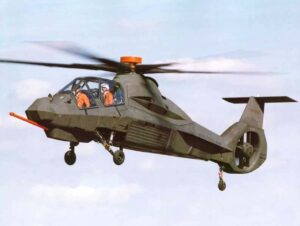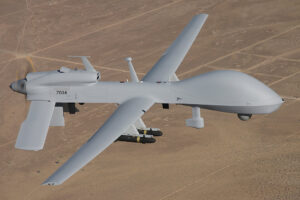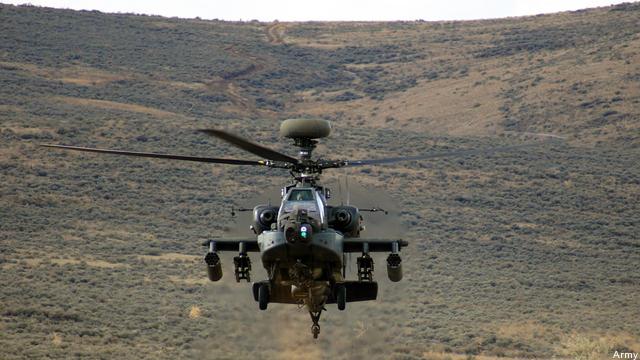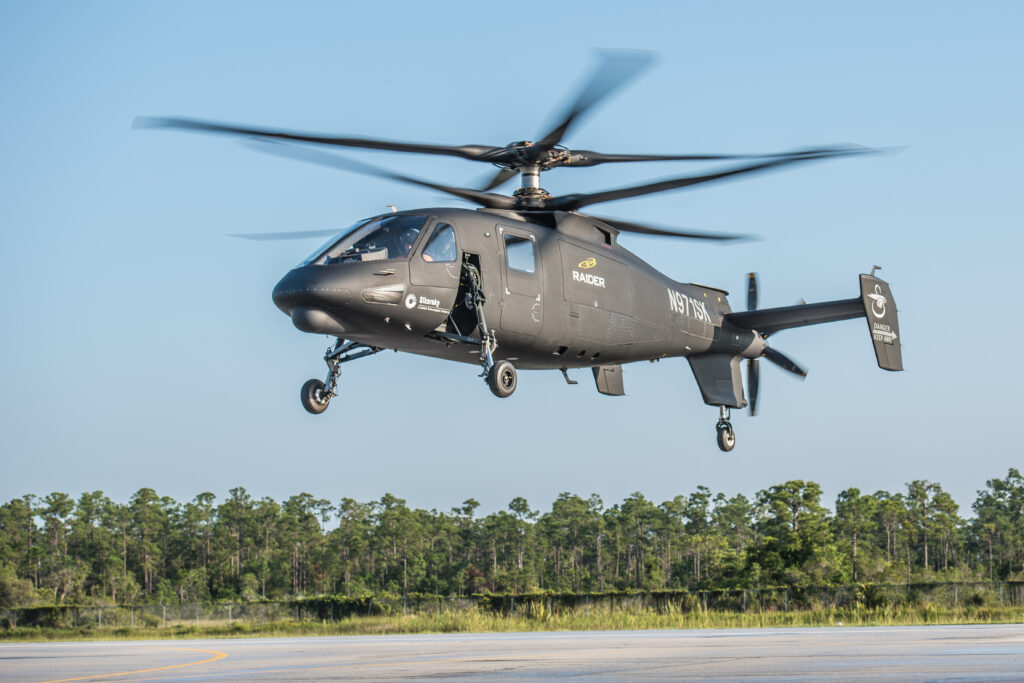
Sikorsky S-97 Raider on its first flight. A “compound helicopter” with both rotor blades and a pusher propeller, the S-97 is widely seen as the leading candidate for the Army’s Future Armed Reconnaissance Aircraft (FARA).
REDSTONE ARSENAL: The Army wants its Future Armed Reconnaissance Aircraft to stick close to the ground troops, Brig. Gen. Wally Rugen told me here, and operate “over the shoulder” of friendly grunts. Manned air and ground forces would work together and protect each other along the front line, while relatively expendable drones and missiles go deep into enemy airspace.
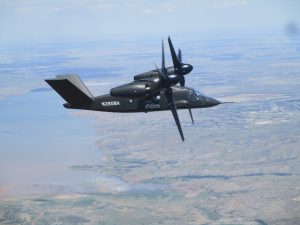
Bell V-280 Valor tiltrotor in level flight with rotors facing forward. The V-280 is widely considered the leading candidate for the Future Vertical Lift assault aircraft but would need to be scaled down for FARA.
After this multi-domain attack has fractured the enemy’s defensive system, the Army’s Future Vertical Lift (FVL) assault aircraft carry troops deep into hostile territory. While FARA itself might be a fairly normal-looking helicopter — its current speed requirement is right on the edge of what current designs can achieve — the FVL assault craft will have to use revolutionary technology to move twice as fast as conventional helicopters to get to the target and back before the enemy repairs his defenses.
That concept’s very much in keeping with the Pentagon’s emerging doctrine of multi-domain operations, which calls for close cooperation between ground and air, manned and unmanned, visible and cyber/electromagnetic, to shatter the defensive layers of long-range precision weapons known as Anti-Access/Area Denial (A2/AD).
The FARA concept also contrasts starkly with the Army’s cancelled RAH-66 Comanche helicopter. The Comanche, an earlier attempt at a scout aircraft, was shaped by the then-current doctrine of “deep attack” (more on that below) and included expensive stealth features to help it penetrate enemy airspace.
“It’s different than the Comanche approach,” in multiple ways, said Rugen, director of the Army’s Future Vertical Lift Cross Functional Team (FVL CFT). How different? In a 30-minute interview, I didn’t hear Rugen didn’t say the words “stealth” or “low observable” once. Unmanned Aerial Systems (UAS), however, came up over and over. The new approach holds out hope that the Army can finally thread the needle between the Comanche, cancelled because of its complexity and great expense, and subsequent attempts to buy an off-the-shelf scout copter, which didn’t offer much of an advance over the venerable Kiowa Warrior it was to replace.
How FARA Fights
While radar stealth isn’t on the menu for the Future Armed Reconnaissance Aircraft, survivability is central. Indeed, if anything, it’s more important in a world where Russia, China and an increasing number of their arms-sale customers have sophisticated radars, anti-aircraft missiles, and networked air defenses specifically designed to keep US airpower at bay.
FARA will probably build on Comanche’s advances in acoustic stealth, since it’s the noise of the rotors, not radar, that historically gives away an approaching helicopter. But the way FARA will survive this future battlefield is different from the vision for Comanche, less dependent on the technology in the aircraft itself and more on how it’s operated to exploit terrain and cooperate with other forces.
First, the FARA aircraft itself will be small, agile, and adept at hiding behind obstacles such as hills and buildings. With a maximum width of 40 feet from the tip of one rotor to another, it could even fly down some city streets. That may seem needlessly hair-raising, but it’s better than hovering in plain sight above the rooftops, waiting to be whacked like a piñata.
For comparison, while the Comanche was only 42 feet long — just a bit too big for the FARA requirement — it was never designed for urban canyons and weighed over five tons. That’s almost twice as much as the OH-58D Kiowa scout it was supposed to replace (or the later ARH-70 Arapaho, also cancelled) and about two-thirds as much as a heavily armored AH-64 Apache gunship.
In other words, instead of trying to make a big aircraft with stealthy coatings and shaping that radar can’t pick up, the Army will make the aircraft small enough to hide behind objects that block radar. Built-in stealth has the advantage that it protects you all the time, while it’s not always possible to stay behind cover — but arguably the most cost-effective radar-blocking material is six stories of concrete and steel that somebody else paid to build.
Second, the FARA will act as a “conductor” for drones, Rugen said. While it will be capable of flying itself with no human aboard (making it optionally manned), it will normally carry one or two crew who can add their trained intuition and curiosity to a variety of drones (UAS):
- Expendable air-launched mini-drones that can carry sensors, decoys, jammers, explosive warheads, or potentially still other payloads. This is a category of drone that doesn’t exist in today’s Army.
- A compact, “runway-independent” Tactical UAS to replace the current RQ-7B Shadow used by Army brigades. The Shadow requires a runway to land and is too big to fit inside the standard CH-47 Chinook transport helicopter, both tactical shortfalls the Army wants to correct.
- A larger and more survivable Advanced UAS to replace the MQ-1C Grey Eagle, used by Army divisions, which is a variant of the now quarter-century-old Predator. While revolutionary in its day, the Predator requires two human crew flying it by remote control at all times and was never designed to penetrate advanced air defenses.
Modern drones, by contrast, are increasingly autonomous, able to fly themselves to human-designated objectives without the constant remote control required for the Predator. But they still depend on human guidance, which requires some kind of long-range data link. Having the humans in a highly mobile aircraft close to the front line, instead of back in a static command post, keeps that link tighter, with lower latency, less vulnerability to jamming, and less dependence on communications satellites.
This may sound similar to how, 15 years ago, the Comanche was advertised as the “digital quarterback” of the battlefield, connecting air and ground forces. But Comanche’s origins in the 1990s didn’t make much allowance for drones — which, by contrast, are central to FARA.
Finally, FARA will keep close to friendly ground troops, that “over the shoulder” symbiosis. Infantry and armor can destroy air defenses on the ground. Nothing takes an enemy’s mind off shooting your aircraft like running him over with a tank. In return, the FARA will use its elevated vantage and attendant drones to see further than the ground troops can. For example, the aircraft will pinpoint threats so US long-range artillery can take them out before they kill Americans. While the FARA will direct the drones, their data will be available via a robust wireless network to the rest of the force.
The context for this concept is multi-domain warfare — but the core concept of combined-arms cooperation has long been fundamental to the Army. In fact, it dates back to the first warlord to combine spearmen, archers, and charioteers in the ancient Middle East. But at times the seduction of new technology can lead commanders astray.
Beyond the Karbala Gap
In Army aviation in the 1980s and 1990s, the introduction of the formidable AH-64 Apache helicopter helped inspire a doctrine of “deep attack,” hitting targets at distances comparable to Army ATACMS missiles or even Air Force fighters. When such long-range raids were well-planned and well-coordinated with other forces, they could be battle-winners. The first shots of the 1991 Gulf War were actually fired by Apaches, staging a surprise attack on Iraqi forward radars to let the Air Force pour through undetected. But such coordination takes a lot of effort, and some Army wargames simply assumed away the problem of enemy anti-aircraft defenses.
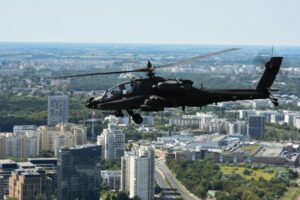
An AH-64 Apache gunship flies over Warsaw. In combat, such a high altitude would make it an easy target for every enemy in sight.
Then, in the 2003 invasion of Iraq, 32 Apaches staged a deep attack through the Karbala Gap, near Najaf, without adequate intelligence on the target, artillery support to suppress anti-aircraft sites or fighter backup. Iraqi spotters with binoculars and cellphones warned their comrades of the incoming helicopters, Iraqi authorities staged a brief power blackout as a signal to start firing, and every Iraqi with a weapon opened fire. While only one Apache was shot down (another had crashed on takeoff), most of the rest were damaged and the mission was aborted.
The Karbala Gap debacle discredited unsupported deep attacks and drove the Army to better coordinated over-the-shoulder tactics. The Iraqis had shown that even a low-tech foe could ambush deep attackers, and high-tech anti-aircraft systems were rapidly proliferating worldwide, including shoulder-fired guided missiles that went missing in Libya. But the Comanche had been conceived in the heyday of the doctrine, and in exercises the prototypes “frequently operated 200 kilometers (125 miles) into enemy territory.” It was designed for the wrong world.
The Army’s emerging multi-domain doctrine has a place for deep attack, but mostly by unmanned assets like drones and artillery missiles, not manned aircraft. As for FARA, Rugen told me, “we don’t really feel like it’s going to be forward of the line of troops (i.e. the front line). It’s not a deep attack.” So, I asked, no more Karbala Gap 2003-type strikes? “Correct.”
The future Army aviation force will have much greater reach across the battlefield, Rugen said, but it doesn’t have to do that with a single super-aircraft. Instead, he said, “we are focused (on) not on just one thing, but an ecosystem” of specialized drones will provide wide-ranging reconnaissance and strike, waging both kinetic and electronic warfare, while the humans hang back to provide direction without dying.
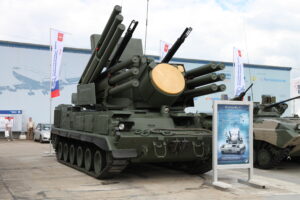
Tracked variant of the Russian Pantsir S1 anti-aircraft missile system (NATO reporting name SA-22 Greyhound)
What’s more, that airborne ecosystem will be in symbiosis with Army ground forces and with long-range strike assets from all the services, be it a cyber attack, jet fighter, extend-range cannon artillery, or missile. Like the Apaches in 1991, Army aviation in the future may end up opening the way for airstrikes, not just for land operations. “We don’t claim to be the one thing that’s going to do it all for everybody,” Rugen said. The objective is to always threaten the enemy from multiple directions, from multiple domains, with multiple methods to impose “multiple dilemmas” to which the adversary has no low-cost counter.
That doesn’t mean the stakes are low for the Future Armed Reconnaissance Aircraft, however. Army aviators are already conducting simulations, playing wargames, and even flying in simulators to test out the FARA concept, with Army Secretary Mark Esper and Chief of Staff Mark Milley keeping a close eye through briefings every two months or so.
“The rigor is important. The rigor is very important,” Rugen said. “We cannot afford….to have a failed program in Army aviation.”

















